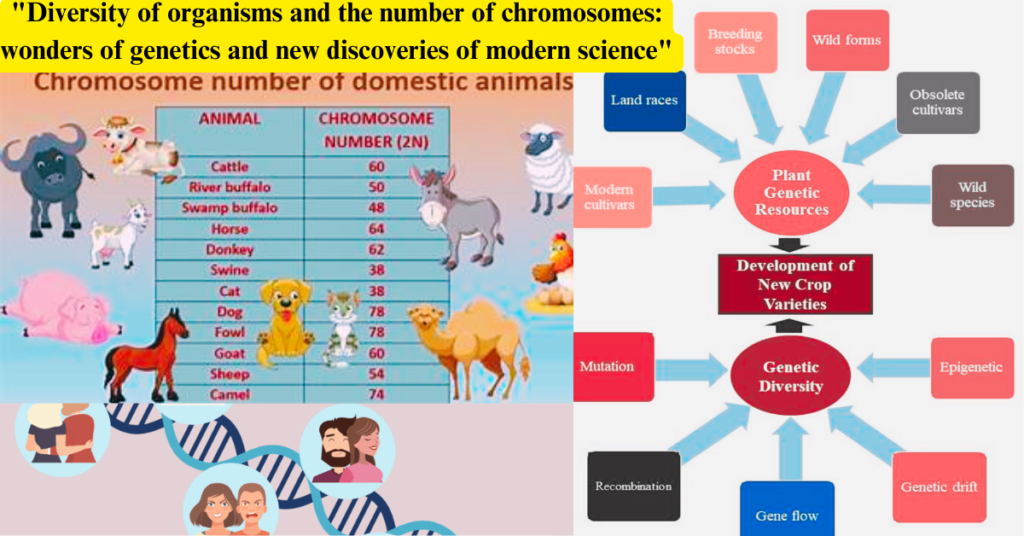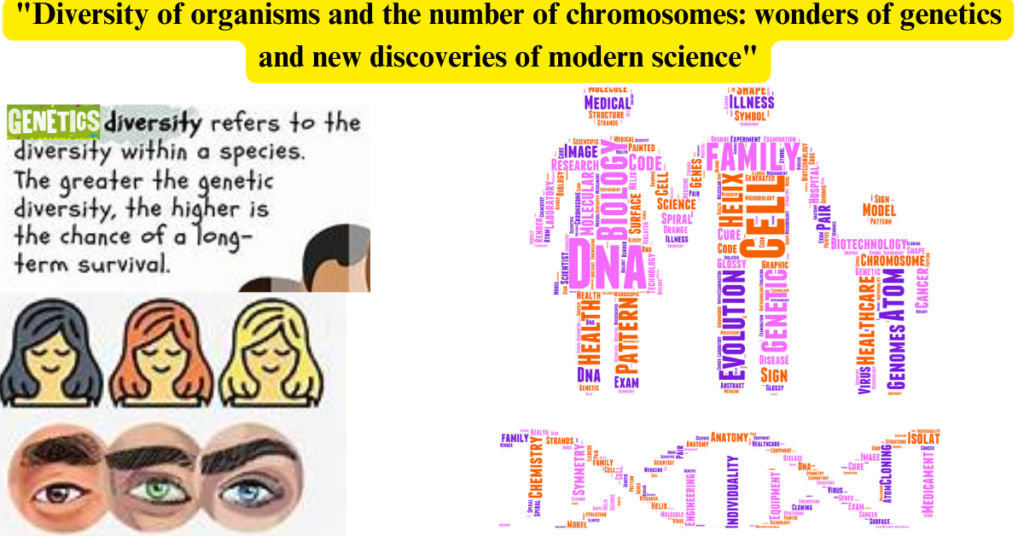
“Diversity of organisms and the number of chromosomes: wonders of genetics and new discoveries of modern science”
Table of Contents
Number of chromosomes tracked down in various types of organic entities: Itemized examination in light of most recent data
“Diversity of organisms and the number of chromosomes: wonders of genetics and new discoveries of modern science” Chromosome is a significant part of each and every living cell, which comprises of a combination of DNA (Deoxyribonucleic Corrosive) and proteins. Chromosomes are tracked down in the core of the cell and assume a significant part in sending the hereditary qualities of life forms from one age to another. The quantity of chromosomes is well defined for each creature, and not entirely settled by its species. This article presents an itemized investigation of the quantity of chromosomes found in various types of life forms and their significance in light of most recent data.
Chromosome: A Presentation
Chromosomes are tiny underlying parts, which are tracked down in the cell of each and every creature. They were first seen by magnifying lens in the late nineteenth hundred years. These chromosomes, comprised of DNA and proteins, are the transporters of qualities, which control the turn of events and actual attributes of any living being. The hereditary codes contained inside the qualities control every one of the attributes of the organic entity, like tone, level, wellbeing, and conduct. Hereditary data is passed from guardians to posterity through these chromosomes.
The quantity of chromosomes is intended for every species, and that implies that all individuals from similar species have similar number of chromosomes. For instance, all people have 46 chromosomes. Be that as it may, a few organic entities might have considerably more or substantially less number of chromosomes, and this variety influences their life cycle and actual construction.
Construction and capability of chromosomes
The design of chromosomes is mind boggling and primarily comprises of DNA and proteins called histones. The main capability of chromosomes is to make a precise duplicate of DNA during cell division and separation it into new cells. This guarantees that the new cells have a similar hereditary data as the parent cell.
- DNA and qualities
Inside the chromosomes is DNA, which is an assortment of hereditary directions. DNA is a long sub-atomic chain, which is in a twofold helix structure. This DNA contains great many qualities, which direct the most common way of making specific proteins. These proteins are fundamental for all cells of an organic entity, like catalysts, chemicals, and other primary parts. - Cell Division and the Job of Chromosomes
Chromosomes assume a vital part during cell division. At the point when a cell separates, the chromosomes split into two sections and are partitioned similarly into new cells. This cycle is called mitosis. In sexual proliferation, the division of chromosomes happens through the course of meiosis, in which around 50% of the chromosomes in the posterity are gotten from the mother and half from the dad.
Number of Chromosomes in Various Species

The quantity of chromosomes is a trademark highlight for any types of living being. Each specie has an alternate number of chromosomes, which mirrors their hereditary design, improvement, and regenerative framework. Allow us to take a gander at the quantity of chromosomes tracked down in a few significant organic entities and their significance.
- Number of Chromosomes in People
People have 46 chromosomes, which are isolated into 23 sets. Of these, 22 sets are called autosomes, while 1 sets is the sex chromosome. Sex chromosomes (X and Y) decide if the kid will be male or female.
Hereditary illnesses, for example, Down condition emerge when there is an irregularity in the quantity of chromosomes. For instance, Down condition has an additional chromosome in the 21st chromosome pair, which causes obstacle in mental and actual turn of events.
- Number of chromosomes in microscopic organisms
Straightforward organic entities like microbes have just a single round chromosome, which holds generally their hereditary properties. Because of the basic design of these organic entities, their genome size is moderately little. - Natural product fly (Drosophila melanogaster)
The natural product fly, which is renowned for hereditary investigations, has just 8 chromosomes. Its little genome makes it an optimal model for logical exploration. Organic product flies have been utilized in the revelation of numerous hereditary standards.
- Horse (Equus ferus caballus)
Ponies have 64 chromosomes. The quantity of these chromosomes influences their actual turn of events, muscle design, and capacity to move. - Elephant (Elephas maximus)
Elephants have 56 chromosomes. These chromosomes assume a part in the colossal construction of elephants and their long life cycle. - Canine (Canis lupus familiaris)
Canines have 78 chromosomes. This number assists them with making sense of the hereditary contrast between various varieties. The distinction in physical and mental characteristics in various types of canines is likewise because of these chromosomes. - Feline (Felis catus)
Felines have 38 chromosomes. These chromosomes influence the nimbleness, vision, and ability to hunt of felines. - Insect
The quantity of chromosomes in bugs can fluctuate significantly. By and large, most bugs have 44 chromosomes, yet this number can go from 24 to 52 in certain species. - Rodent (Rattus norvegicus)
Rodents have 40 chromosomes, and are broadly utilized in clinical examination and medication testing. The genome of rodents imparts numerous likenesses to the human genome, making them utilized in research.
Number of Chromosomes in Plants
Plants additionally have various quantities of chromosomes, and this influences their development, crop creation, and sickness obstruction.
- Wheat (Triticum aestivum)
Wheat has 42 chromosomes. This plant is polyploid, and that implies it has various chromosome sets. This property helps in expanding crop creation. - Maize (Zea mays)
Maize has 20 chromosomes, which control its development and yield potential. Hereditarily altered maize plants have been displayed to have further developed sickness obstruction and creation effectiveness. - Rice (Oryza sativa)
Rice has 24 chromosomes. Concentrating on the number and design of chromosomes in various assortments of rice is a significant region for researchers, as it can work on the efficiency and nature of the harvest. - Potato (Solanum tuberosum)
Potatoes have 48 chromosomes. The intricate construction of potato chromosomes empowers it to be shielded from numerous sicknesses and produce improved yields. - Cotton (Gossypium hirsutum)
Cotton has 52 chromosomes. The creation limit of cotton and the nature of its fiber are additionally impacted by the quantity of chromosomes.
Irregularity in the quantity of chromosomes: Polyploidy and hereditary problems
- Polyploidy
Polyploidy happens when a living being has more chromosome sets than the ordinary chromosome number. This is especially normal in plants and builds their illness opposition, development, and harvest creation. For instance, plants, for example, wheat and potatoes are polyploid. - Hereditary Issues
Irregularities in the quantity of chromosomes in people and different creatures can cause issues. For instance, Down condition includes an extra 21st chromosome. Likewise, Klinefelter condition is a problem wherein guys have an additional X chromosome. In Turner condition, females miss the mark on X chromosome, creating issues with development and generation.
Most recent Advances in Hereditary qualities
Current science has made numerous significant advances in the investigation of hereditary qualities and chromosomes. Advances, for example, CRISPR-Cas9 have simplified quality altering and exact. Through this, researchers are currently ready to supplant or alter explicit qualities, making treatment of hereditary sicknesses conceivable.
Moreover, through genome sequencing innovation, researchers can now peruse the total genome of any creature and figure out its hereditary design. This innovation is ending up progressive in the investigation of numerous hereditary sicknesses and problems.
End
Chromosomes are a significant piece of the hereditary design of any creature. Various species have various quantities of chromosomes, which control their hereditary attributes, improvement, and actual design. The most recent hereditary qualities research has gained huge headway in the investigation of chromosomes and qualities, opening up opportunities for answers for some serious sicknesses and hereditary issues of humankind.


